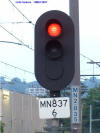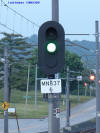This is an accounting of my attempts at model railroads N scale and HO or OO. I find it to be a lot of fun. I concentrate my efforts on The New York Central, Ann Arbor, Pere Marquette, Chesapeake and Ohio as it relates to the Pere Marquette, Michigan Central Railroads and my own Salt Creek Railroad. I am also interested in the Tuscola and Saginaw Bay Railway, the Great Lakes Central Railroad, CSX, Norfolk Southern, Union Pacific, and BNSF. You are welcome to give me advice.
Barry's Model Railroad


Search This Blog
Wednesday, February 25, 2015
Train Whistles And What They Mean
Whistle code
Train whistles are used to communicate to other railroad workers on a train or to railroad workers in the yard. Different combinations of long and short whistles each have their own meaning. They are used to pass instructions, as a safety signal, and to warn of impending movements of a train. Despite the advent of modern radio communication, most of these whistle signals are still used today:
One short: Stop or stopping; apply the brakes
One long: Approaching railroad station or junction (if moving), or apply air brakes and equalize pressure (if standing)
Two short: A general answer signal or acknowledgement; identical to the "roger" or "10-4" radio terms
One short, one long: Inspect the train
One long, one short: Visibility obscured
Two long: Train is about to proceed forward; release the brakes
One long, two short: Additional section follows signaling train
Two long, one short or two short, one long: Train is approaching a meeting or waiting point
Two long, one short, one long: Train is approaching a grade level crossing (i.e. a road crossing). This is a widely used safety signal used to warn motorists and is blown at every grade level crossing, except where local noise ordinances prohibit it. Known in railroad rulebooks as rule '14L'
Three short: Train is about to proceed in reverse (if standing), or train is about to stop at the next station (if moving)
Three long: Train cars have come unhooked; train has come apart
One long, three short: Flagman, go protect the rear of the train
One short, three long: Flagman, go protect the front of the train
Four short: Request for signals
Four long: Flagman, return to the train from the west or north
Five long: Flagman, return to the train from the east or south
Four short, one long: Fire alarm; fire on the train
Multiple short: Danger, get off the tracks! Used to warn pedestrians or livestock who are on the tracks in front of the approaching train.
For an abbreviated quick reference and for hand signals go to this URL
http://www.southerncalifornialivesteamers.com/SCLS_Live_Steam_Railroad_Whistle_Signals.asp
Railroad Signals Reading And Meaning Parts1,2,&3
3 parts
Just copy and paste these URL's into your browser
Part 1
Part 2
Part 3
The above offer an understandable explanation of railroad signals for North America
Just copy and paste these URL's into your browser
Part 1
Railroad Signals, reading and meanings, part 1: The basic three light system
https://www.youtube.com/watch?v=tJpR93kp44IPart 2
Railroad Signals, part 2: 1 and 2 head systems - reading and meanings
https://www.youtube.com/watch?v=16jXTDfEavAPart 3
Part 3: Railroad Signals, reading and meanings. Diverging and Limited speeds, to and at signals
https://www.youtube.com/watch?v=b4lUiaWT8wEThe above offer an understandable explanation of railroad signals for North America
Tuesday, February 24, 2015
The Manufacturers of American Railroad Signal Equipment
RAILROAD SIGNALS of the U.S.
A PRIMER ON AMERICAN RAILROAD SIGNALS
The Manufacturers of American Railroad Signal Equipment
Here are links to the manufacturers websites:
1) Federal
2) GE - Harmon http://www.getransportation.com/na/en/signalingcommunications.html
3) General Signal http://www.generalsignals.com/
4) GRS - General Railway Signal / now Alstom http://www.alstomsignalingsolutions.com/OurProducts/WaysideProducts/Signals/
5) Griswold
6) Hall Signal
7) National Railway Signal Co
8) Safetran (Invensys Rail Group) http://www.safetran.com/
9) Saxby Farmer
10) Seermi Products http://www.serrmi.com/
11) US&S - Union Switch & Signal http://www.ansaldo-sts.com/AnsaldoSTS/EN/index.sdo
12) WABCO - Westinghouse Airbrake Co
13) Western Cullen Hayes http://www.wch.com/
14) Western Railroad Supply
More pictures of vintage equipment can be found here and here
Federal Signal Company
GE-Harmon
General Signal
GRS - General Railway Signal
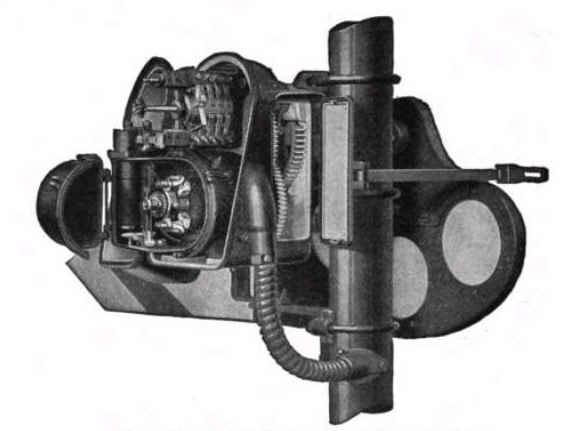
GRS Model 2A Semaphore motor.
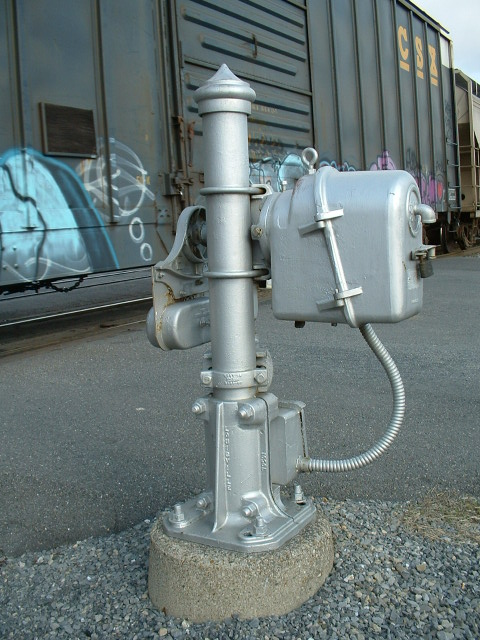
A pedestrian crossing gate that uses a GRS semaphore motor in Cumberland. These are still fairly common, as I have recently seen them in Darby PA, Cumberland MD, near Berea OH, Harrisburg PA, Lancaster NY, and Allentown PA.
Griswold
Griswold made crossing gates, and a unique style at that. They were based out of Minneapolis MN, and as such, the majority of their equipment was seen in that area.
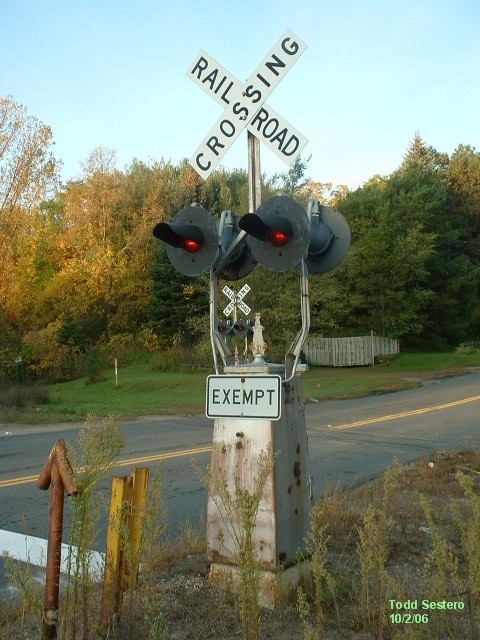
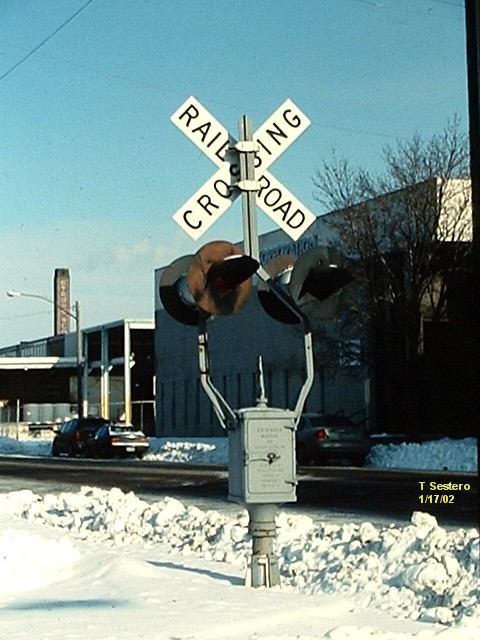
(L) An unused grade crossing in Burnsville MN, at 155th St W and Kenwood Trail.... 1/2mi north of 162nd St W, which is exit 86 off of interstate 35. The bottom part of the housing, in which the motor sits, was made by Raco. It is missing the rotating stop sign.
(R) A Griswold still in service on the Minnesota Commercial, a little south of Fridley and BNSF's North yard. This one no longer has a stop sign either.
the Hall Signal Company
The Hall Signal Company was in existence from 1871 to 1925. Hall is mainly remembered for its marvelous Disc Signals. (Yes, Virginia... even the N&W had a couple of Hall Disc Signals!)
In 1920, Hall introduced the first Searchlight Signal and was thereafter very quickly bought up by Union Switch & Signal.
Hall also made the early B&O CPL signals.
Below is a postcard, postmarked 1919, showing the Hall Signal Co's works in Garwood, NJ. Below that is a cigar cutter from 1902, given away by the company. These two pictures are courtesy ADB.
Pictures found from various places around the internet and from sources such as Google's digital book saving collection.
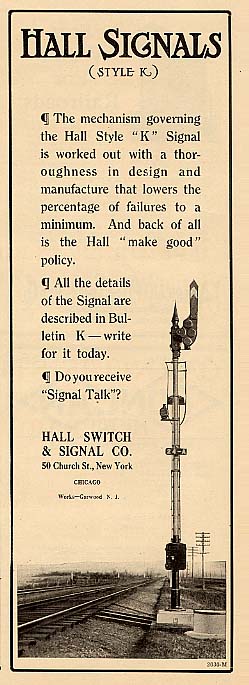
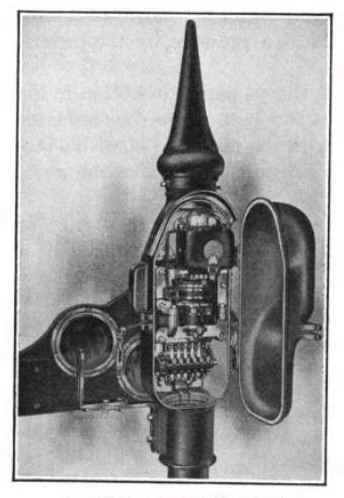 Hall Tyke K Semaphore.
Hall Tyke K Semaphore.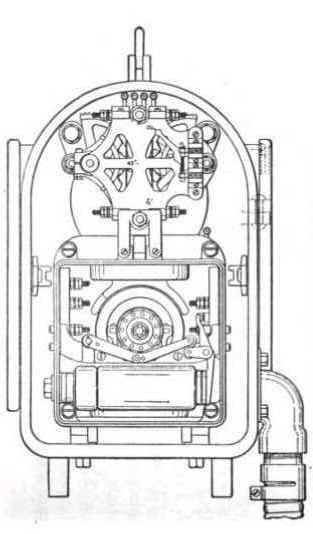
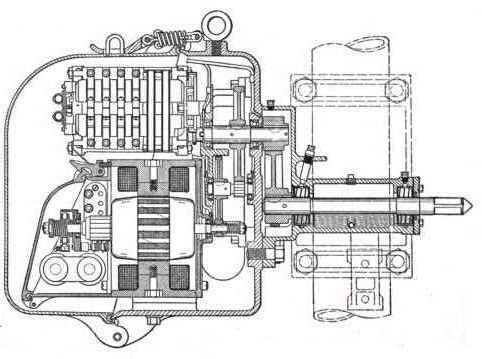 Cross sections of Hall motors.
Cross sections of Hall motors.Magnetic Signal
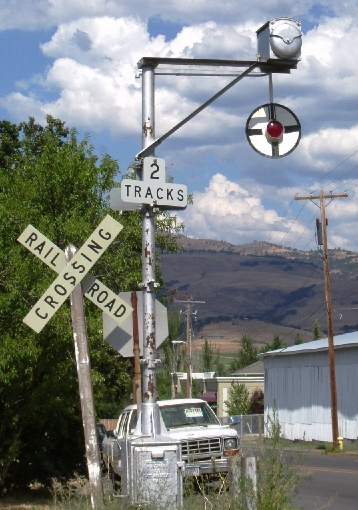
A lower quadrant Magnetic Signal wig-wag in Ashland Oregon, photo by Robert Ashworth.
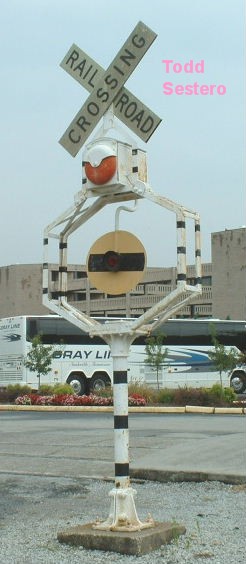
You can find this Magnetic Flagman at the Chattanooga Choo Choo in Tennessee.
National Railway Signal Co
I don't know much about them. They were located in Easton PA, and if that name sounds familiar, look on the bottom of a box of Crayola Crayons :-)
I'm looking for pictures of their signals if anyone has some they would like to share. All I can offer right now are pictures of a relay that appeared on EBay.
Two rumors afloat: one is that the company was started by someone that used to work for the Lehigh Valley RR, and two, Ziegler may have been the name of a "bigshot" within National.
According to one source, National made two models of Ziegler relays, one with 8 points (poles), and one with 4 points, nicknamed the "big Zig" and the "Little Zig". For additional photos of this relays, check out my relay page here.
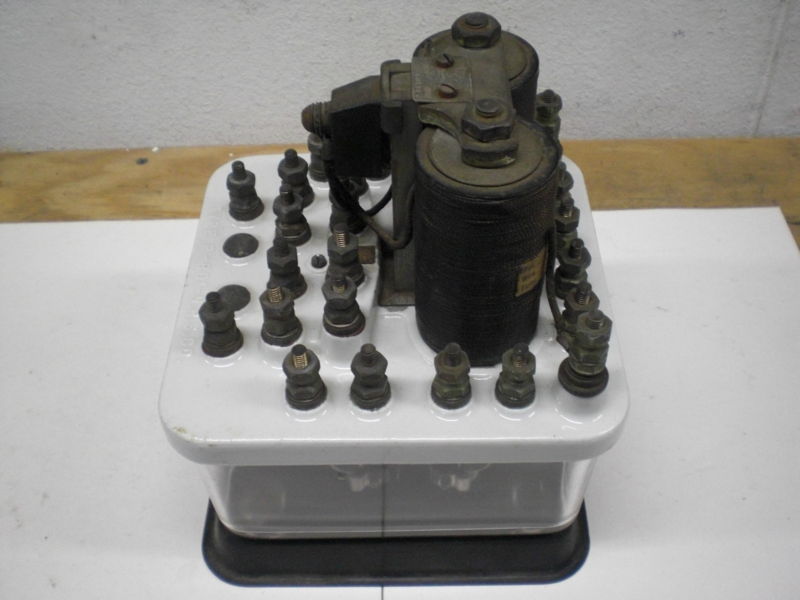
Safetran
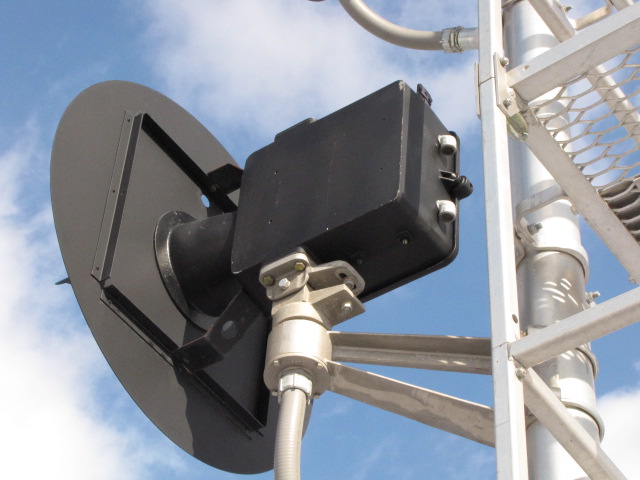
This is a Safetran Unilens signal. This particular installation is on the south end of a CP Rail siding in New Milford PA, between Binghamton NY and Scranton PA.... off I-81 at exit 223. They are similar in appearance to a searchlight from afar, but use a separate bulb for each aspect, using fiber-optics to funnel the light to the lens.
Saxby Farmer
Saxby Farmer made interlocking machines you would find in towers. The tower operator would move the levers to actuate signals and move switch points.
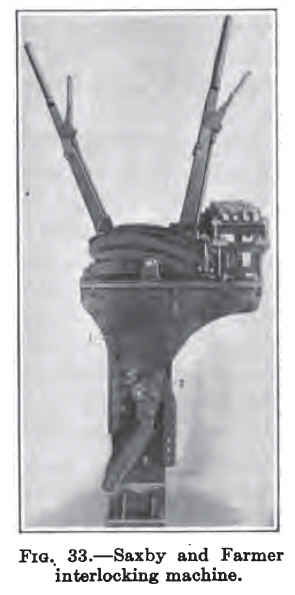
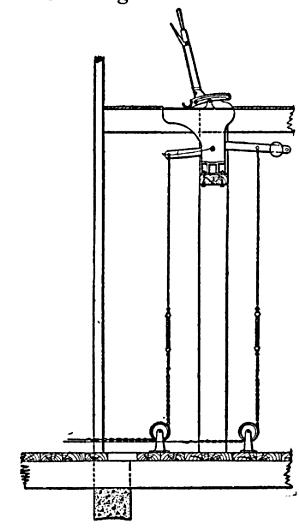
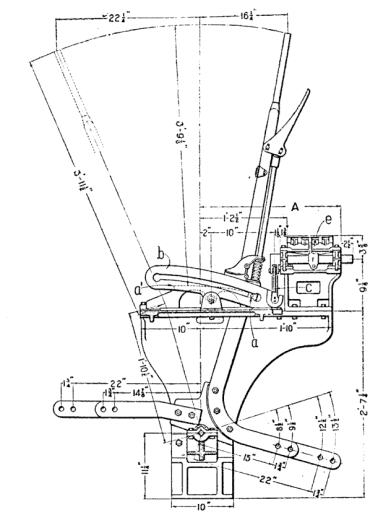
Seermi Products
US&S - Union Switch & Signal
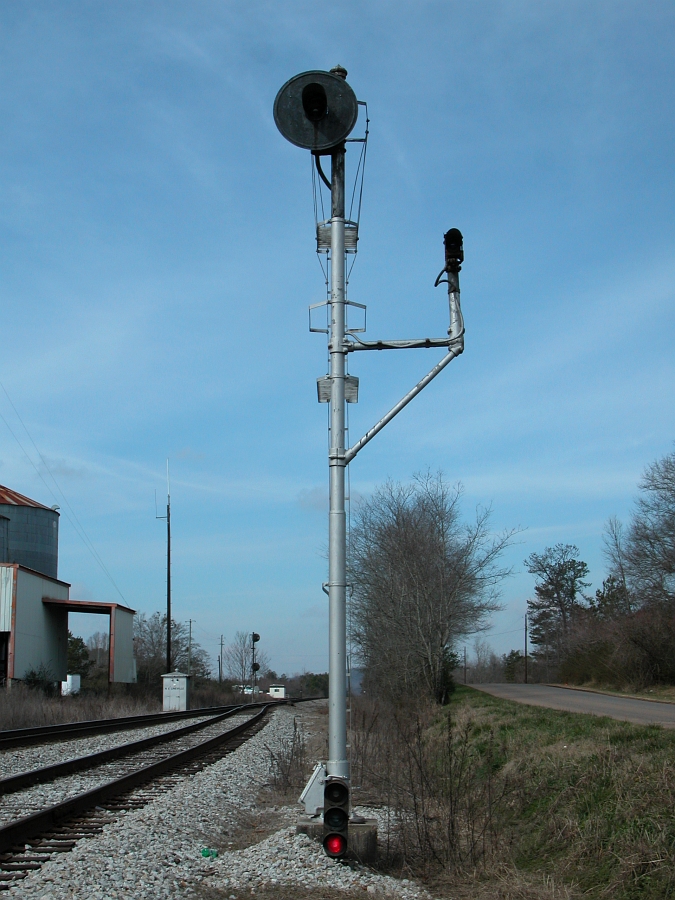
US&S Searchlight signal with a doll post in Lineville AL on an ex-SCL line. Photo courtesy John Higginson.
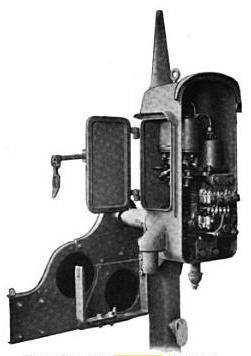
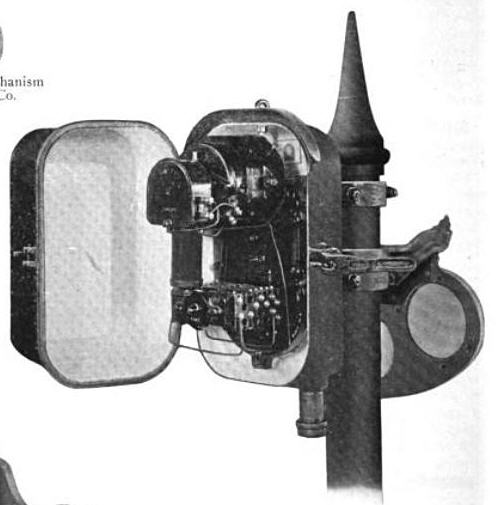
US&S Semaphores operated by electro-pneumatics (L), and electric (R).
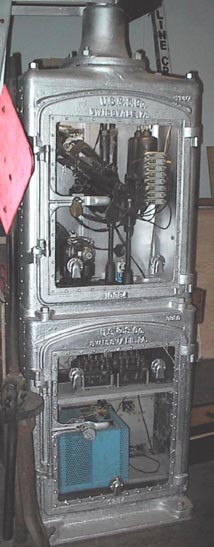
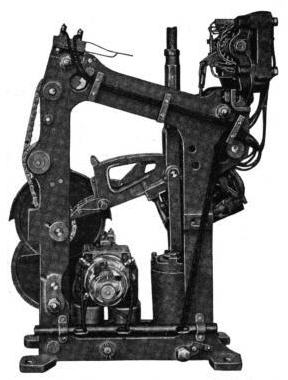
US&S base-of-mast motor assembly, the actuating rod at the top of the picture would go up thru the pole to move the semaphore spectacle.
WABCO - Westinghouse Airbrake Co
Western Cullen Hayes
WRRS - Western Railroad Supply
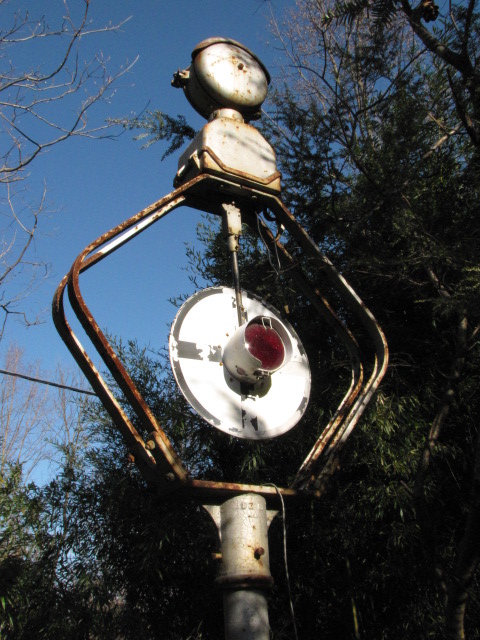
A wig-wag type crossing gate signal by WRRS, in my back yard... came off the CNW in western Wisconson.
Reading And Interpreting Railroad Signals 2
RAILROAD SIGNALS of the U.S.
PRIMER ON AMERICAN RAILROAD SIGNALS
Reading And Interpreting Railroad Signals 2
Red as Place Holder A Simple Concept.
Staggered Heads and Absolute vs Permissive Why the railroads came up with this indication and it's impact on operations.Stop Signals vs Grade Signs Another way a railroad can help to control costs.
Blanking out unused positions A simple way to control your inventory.
Signal Spacing How it changes the meaning of a signals indication.
Signal Bridges When you have more than one track to signal.
Doll Posts A placeholder for un-signaled tracks.
Backgrounds Helping with the visibility of a signal.
Multiple Heads
 Railroads can normally use a single head signal for wayside signals, if the only purpose is to tell the engineer the condition of the track ahead of him. If the signal designer wishes to tell the engineer more, they add additional heads. A single head is usually a high speed signal, meaning the the engineer is allowed to go the maximum speed authorized by his handbook or timetable for that particular section of track if he has a clear. The picture to the left is on the south side of Pigs Eye yard in St Paul MN, and shows a pair of three head searchlight signals.
Railroads can normally use a single head signal for wayside signals, if the only purpose is to tell the engineer the condition of the track ahead of him. If the signal designer wishes to tell the engineer more, they add additional heads. A single head is usually a high speed signal, meaning the the engineer is allowed to go the maximum speed authorized by his handbook or timetable for that particular section of track if he has a clear. The picture to the left is on the south side of Pigs Eye yard in St Paul MN, and shows a pair of three head searchlight signals.
With the addition of more heads, the top head is the high speed head, the middle head is for medium speed moves, and the bottom head is for slow speed moves.
With a green on top, or G/R/R, as it is usually referred to, it authorizes the engineer to proceed at the maximum allowable speed for that section. Move the green down to the middle position, R/G/R, however, and the meaning changes. Now the indication is "medium clear", and the maximum allowable speed is (usually) around 30MPH. Bumping the green down to the bottom head, R/R/G, and the indication is now a "slow clear", and limits the trains speed to 15MPH.
So why do they want to control the speed of a train? For a variety of reasons: a move thru a set of crossovers, a move onto a siding, going onto a diverging route, bad track, workers present on the right-of-way, etc. Most, if not all rulebooks, state the the entire train has to pass through the switches, or pass the signal, before the train can resume a higher speed.
In addition to the colors of a signal, the meaning can also be modified by having the aspect flash. In almost all circumstances on railroads, a flashing aspect makes the signal more restrictive.
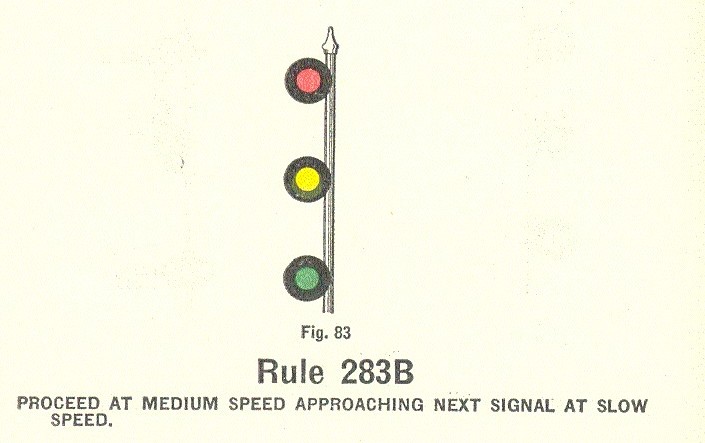 To further complicate the interpretation of a signals meaning, railroads employed multiple non-red aspects, such as Y/Y/R, which on many railroads would be an "advance approach", sort of like having a distant semaphore giving you an indication of the signal two signals away, allowing the engineer more time to prepare for speed changes. The New York Central, for instance, employed a R/Y/G signal, which stated the engineer had to proceed at medium speed, approaching the next signal at slow speed, in other words, he could pass this signal at medium speed, but had to reduce the speed of the train right away so he wouldn't be going faster than 15MPH when he came upon the next signal - it still really follows the medium and slow speed guide for the meaning of the position of the heads.
To further complicate the interpretation of a signals meaning, railroads employed multiple non-red aspects, such as Y/Y/R, which on many railroads would be an "advance approach", sort of like having a distant semaphore giving you an indication of the signal two signals away, allowing the engineer more time to prepare for speed changes. The New York Central, for instance, employed a R/Y/G signal, which stated the engineer had to proceed at medium speed, approaching the next signal at slow speed, in other words, he could pass this signal at medium speed, but had to reduce the speed of the train right away so he wouldn't be going faster than 15MPH when he came upon the next signal - it still really follows the medium and slow speed guide for the meaning of the position of the heads.
An excerpt from my New York Central aspect page.
The indication also has different meanings on whether the railroad employs route or speed signaling. In the SR example, a green in the middle would indicate a "diverging route clear", where the train can proceed thru the diverging route observing the authorized speed thru the crossover or turnout (which would be specified in the rulebook). On the old New York Central routes, a green in the middle would be a limited clear, limiting speed to 40 or 45MPH, not necessarily thru turnouts.
Old railroaders use the phrase "if it ain't all red, it ain't red at all", meaning any colors displayed in the signal other than red make the signal less restrictive than stop.
Red as place holder
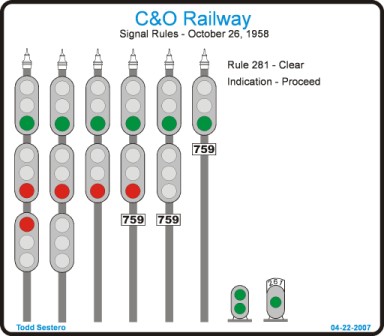
On multiple head signals, regardless of the type of signal used (color light, searchlight, etc), red is used as a placeholder. Take, for instance, a three head signal showing green over red over red (G/R/R). I can't think of a railroad that doesn't have this in their books as a clear signal. The plate to the left illustrates the concept as practiced on many railroads.
All of the signals pictured display the same indication, clear, regardless if there are 1, 2, or 3 heads.
This discussion also brings us around to the rule on most railroads that an improperly displayed signal is considered the most restricting aspect, mainly, stop.
Darkened Heads
The above example also illustrates another common practice of "darkening" the bottom signal, if it's not needed for the indication. With 2 or 3 head signal installations, they could choose not to light up the bottom head, where red is used just as a placeholder anyway.
 This practice has fallen out of favor with the FRA, so it's use it not as widespread as it used to be. This is because, on non-color light installations, as with searchlight signals, a bulb could be out, and the bottom head would then NOT be able to display a green or yellow. A lamp out in a signal is considered a red, so, with a three head searchlight location like the one at Pigs Eye at the left, the signal would not be able to display a R/R/G or R/R/Y indication if the bottom bulb was out, and the engineer would have to interpret the signal as a stop signal. There would be no way for the engineer to know from looking at the signal if the bottom head was a red, or the bulb was out and was supposed to be yellow or green, and would have to bring the train to a stop if he only saw a R/R.
This practice has fallen out of favor with the FRA, so it's use it not as widespread as it used to be. This is because, on non-color light installations, as with searchlight signals, a bulb could be out, and the bottom head would then NOT be able to display a green or yellow. A lamp out in a signal is considered a red, so, with a three head searchlight location like the one at Pigs Eye at the left, the signal would not be able to display a R/R/G or R/R/Y indication if the bottom bulb was out, and the engineer would have to interpret the signal as a stop signal. There would be no way for the engineer to know from looking at the signal if the bottom head was a red, or the bulb was out and was supposed to be yellow or green, and would have to bring the train to a stop if he only saw a R/R.
Staggering Signals: Absolute vs Permissive.
AKA Stop vs Stop and Proceed
AKA Stop vs Stop and Proceed
Under normal circumstances, an engineer approaching a Stop Signal would have to completely stop his train and wait until the signal became more favorable before proceeding. This is called an Absolute Signal. Some railroads call this "Stop and Stay" as opposed to just a Stop Signal.
In some places, the railroads decided they could have the train stop, and then proceed at a restricted speed, looking for anything that might cause an accident. This is called aPermissive Signal. Railroads came up with the idea to place a number plate below the signal to denote a Permissive Signal, but in the old days before reflector type signs, and good headlights, this posed a problem at night.
So how could the engineer tell at night if the signal he was approaching was a stop and proceed signal? The New York Central and New Haven, among others, staggered, or offset the lights, so at night, there was a visible difference in the appearance of the signal.
The left photo below is of a New Haven semaphore in the Bronx from back in the early 70's, and demonstrates how the upper signal is to the left of the mount, and the lower semaphore is to the right (Going back to a discussion in the semaphore section, each semaphore is it's own signal, in contrast to other forms of signals where multiple heads still are considered as "one signal").
The photo in the middle is an example of this practice on the ex-NYC mainline between New York City and Buffalo, in Corfu NY. Notice that both signals also have a number plate displayed. The number plates and staggering of the signals only modified the meaning of the stop aspect, all other indications remained unaffected. The NYC shot also illustrates what AA Krug refers to in his discussion about the need for safety, where they didn't really need two heads, but used the extra head anyway. (look at he track ahead and you'll see there are no diverging routes, so one signal could have sufficed here). BTW, A little further down the track (westbound), where there are some crossovers, they do used three searchlight heads.
The right photo illustrates this practice in Gastonia NC on the former Southern Rwy.
Notice that the NYC and New Haven had the upper head offset to the left, and the Southern had it to the right.
Note that all three have number plates! It is fairly universal for numbered signals to be permissive. One exception was the Rio Grande, who numbered all of their signals. The DRGW called Absolute Signals Positive Signals, and used the letter "P" just above the number plate (Thanks to Mike McLaughlin on the Yahoo Signaling group for this tidbit of information in December of 2010).
As a recap, signals above one another in a straight line are absolute, signals that are staggered are permissive. Some railroads would also employ an "A Plate" to signify an absolute signal.
Below the photos is an excerpt from a CNW rulesheet out of a CORA manual. It shows a couple of things pertinent to our discussions.
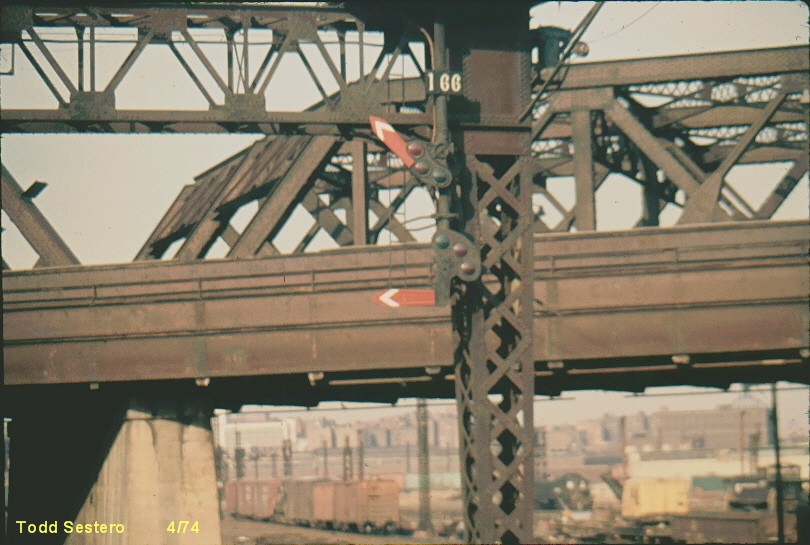
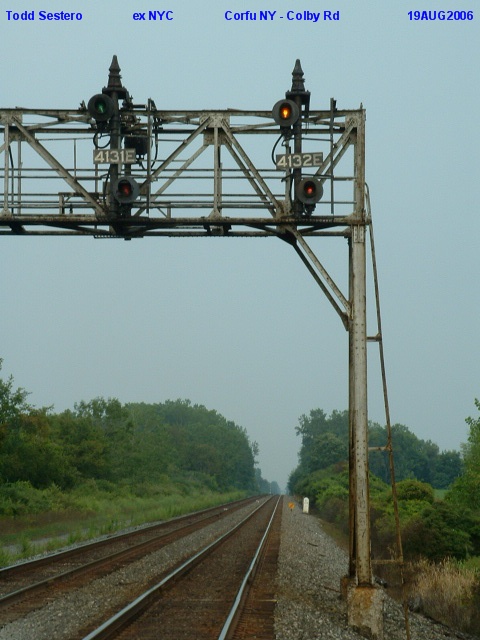
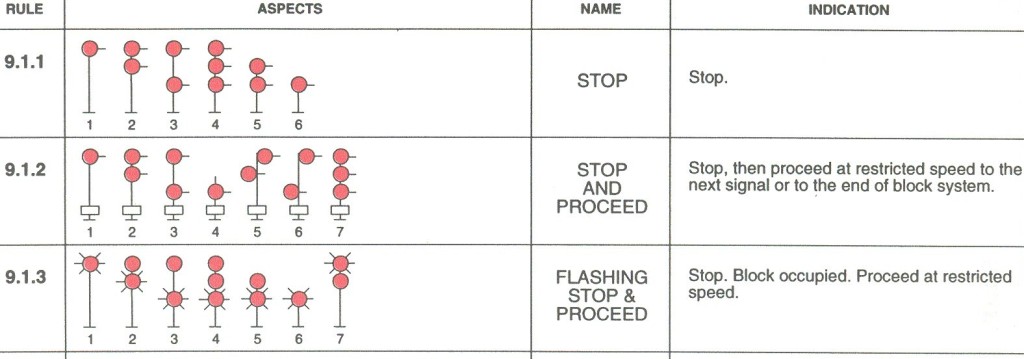
Stop Signals and Grade Signs.
Railroads, in their ever clever ways to save even more money, came up with a modification to the stop rule for heavy tonnage trains on a grade, that would require a severe penalty in time and fuel to get the train moving again once given a more favorable indication, or braking distance if on a down grade. This was the grade sign. Heavy tonnage trains can roll by a stop signal at restricted speed if the signal has a grade sign displayed, usually as shown below in the two examples. The left and middle photos are of a CSX/ex-B&O grade sign on a CPL signal in Gaithersburg MD, and the one on the right is at the south end of Pigs Eye yard in St Paul MN, easily viewable from US10.
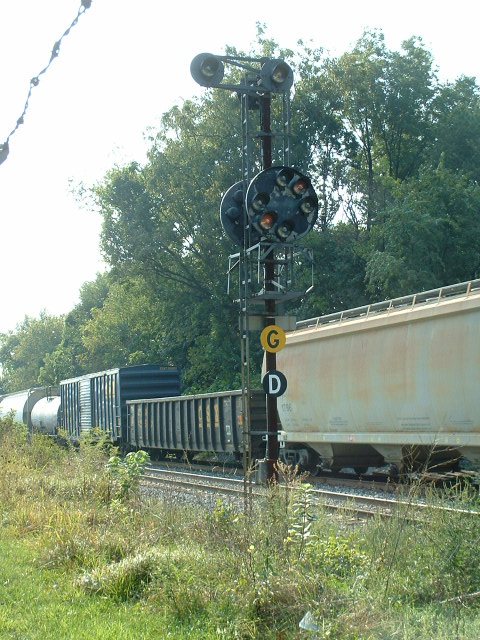
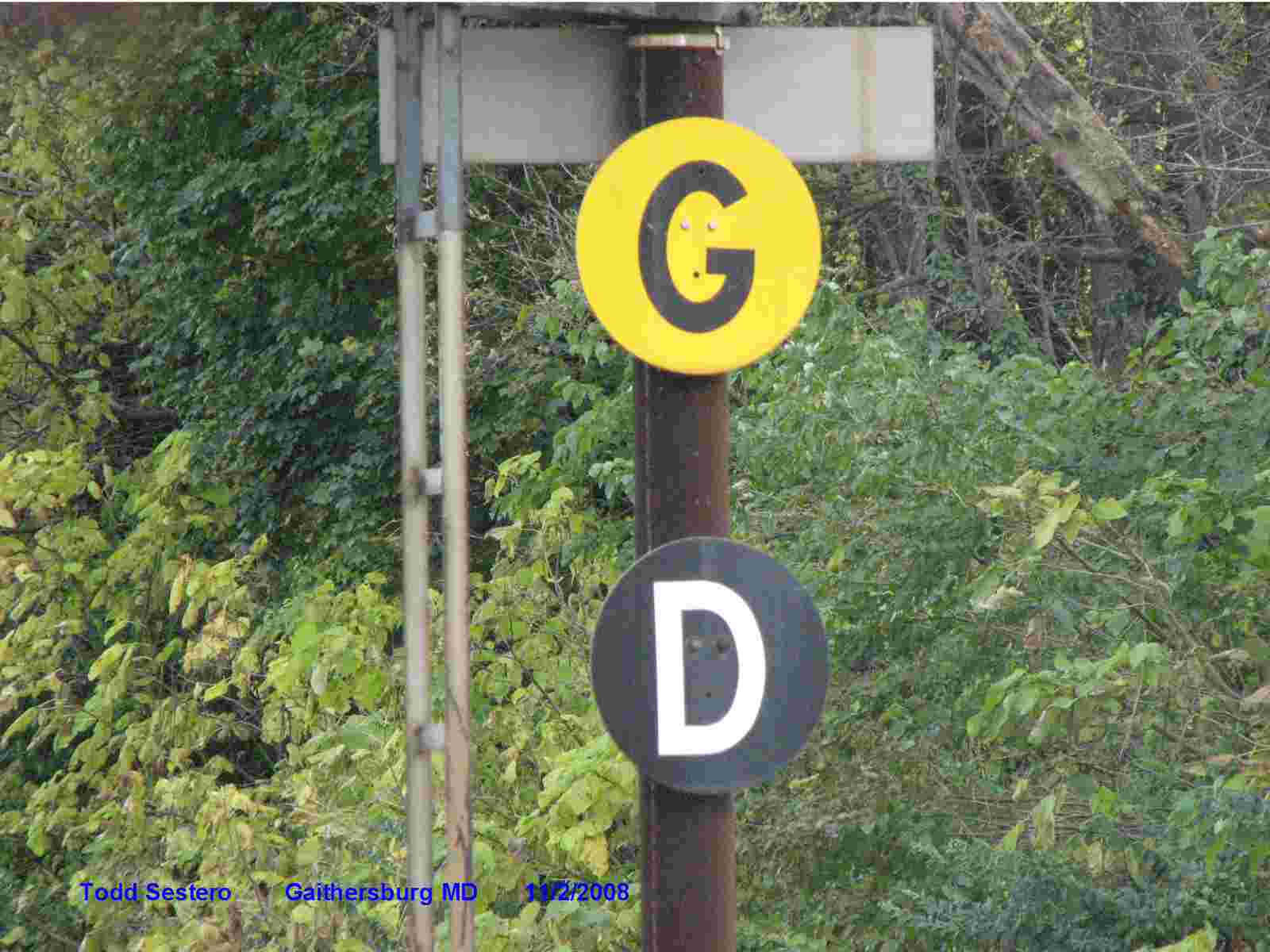
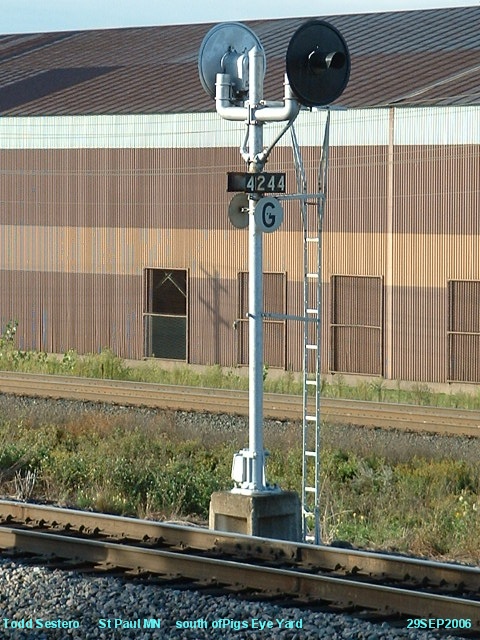
Blanking out unused positions
This practice is used when a signal head does not need all of the available aspects the head is capable of displaying.
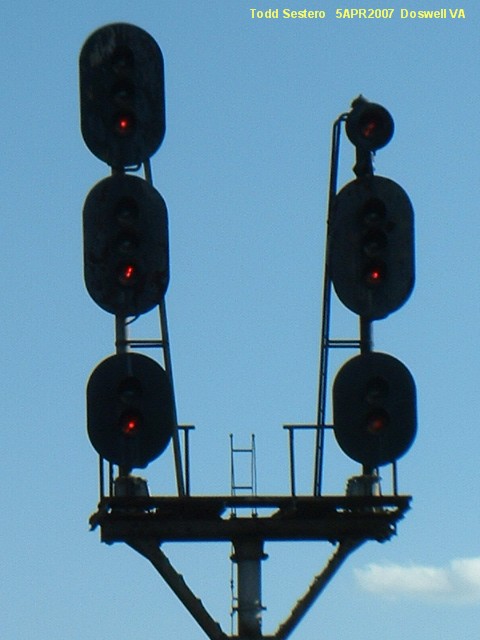
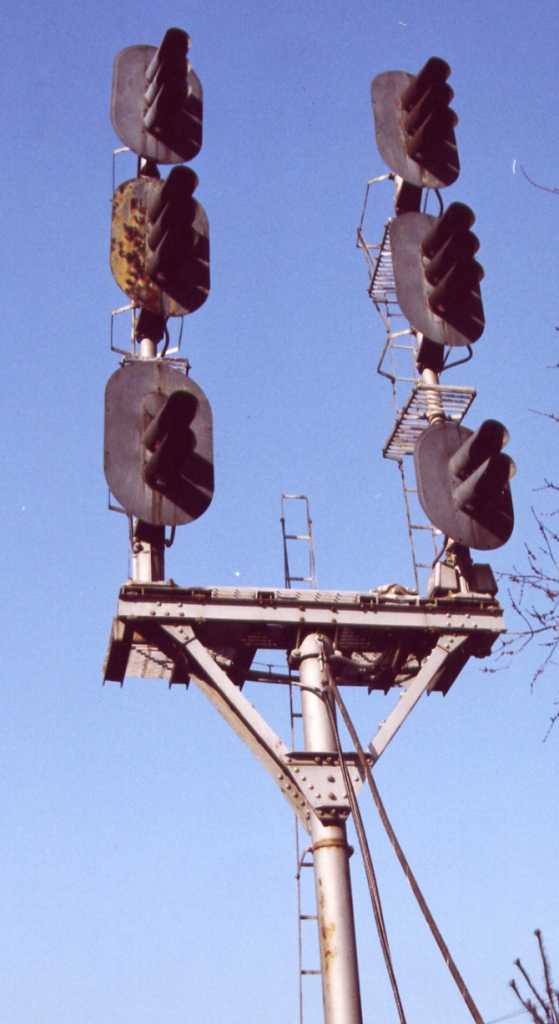
On most railroads, they would use an appropriately sized head, out of consideration for cost. If they only needed one or two aspects in a particular position, they would use a one or two position signal head, as shown to the left on the old RF&P line at Doswell VA. The right signal is only capable of displaying medium or slow speed indication since the top head is always red.
On the right, it shows the bottom head on the left having the green aspect being blanked out, but on the right, they use a two aspect head. Why? Maybe they downgraded the slow speed head so it could only give us a slow approach, and not a slow clear. Or maybe they ran out of two aspect heads.... Don't know from looking at the signal, but those are two possibilities. Notice that the bottom head on the left shows red in the middle position. Photo by Jim Mihalek.
In other instances, such as many transit companies, they want to contain costs in a different way, so to keep different signal heads in stock, would cost more than the occasional use of blanking an aspect, as shown in the photos below at the Gilroy station on the Baltimore light rail, where the tracks goes from two to one for it's ride through the Hunt Valley Industrial Park.
Then there are the Pennsy PL and B&O CPL signal heads. The B&O did not have a "shortened" version of it's signal head like the Pennsy did for it's lower head. This meant they had to blank out all of the unused positions. The restrict only B&O signal (in S Baltimore) below shows this. The picture to the right shows a B&O signal (also in S Baltimore) with just the restrict aspect blanked out.
The middle picture shows a Pennsy PL head with just a stop aspect, with all of the other possibilities blanked out. The other two Pennsy signals other variations of blanking out unused positions. From left to right of the Pennsy pix, Columbia PA, Northumberland PA, and the west bank of the Rockville Bridge in Marysville PA.
Signal Spacing
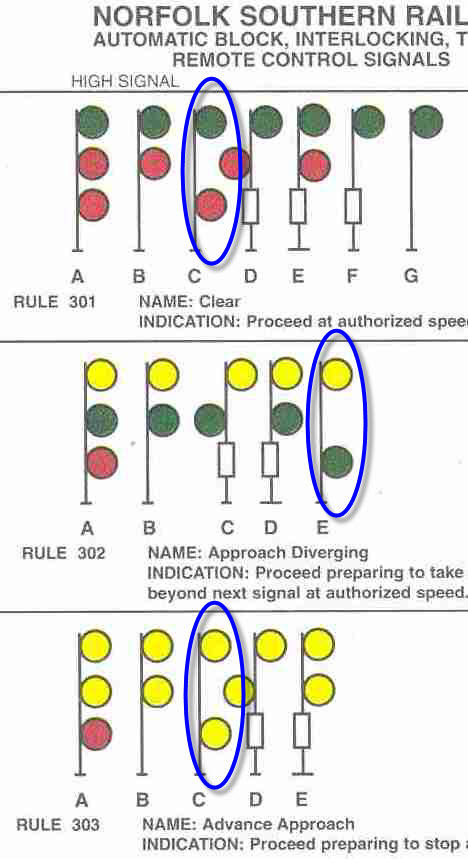
Another way the railroads saved money is illustrated to the left. This was to leave out the "middle" signal if they had no medium speed moves at a particular location. An engineer could tell that the lower head was a slow speed signal, by the larger than normal spacing of the two sets of signals, although, since engineers have to qualify on particular sections of track, the signals should not come as any great surpise.
Signal C for Clear, signal E for Approach Diverging, and signal C for Advance Approach are the signals of interest.
The scan on the left is from the Norfolk Southern rulebook for the Kentucky region.
The photo below illustrates this practice. Compare the two signals in the picture, and you will notice the larger than normal spacing between signal heads, compared with the three head signal in the background. A train approaching the restrict signal would have just come through Tower 87 in Houston TX, headed into Settegast Yard. Depending on the indication the engineer receives next at the stop signal, he could get cleared to proceed into the yard, or take a diverging move to the left and head up to the Gulf Coast Junction.
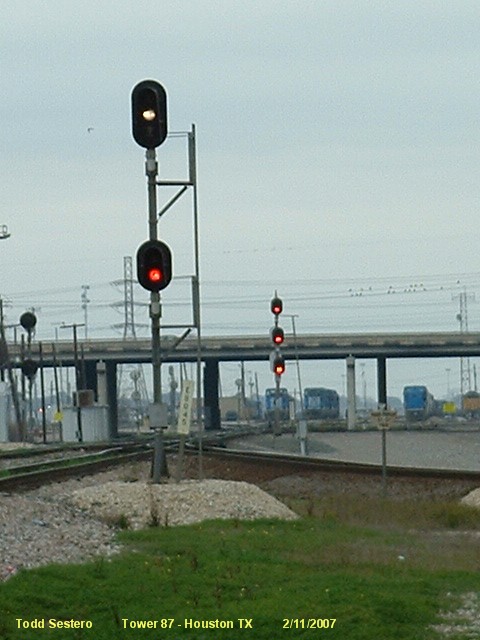
Signal Bridges
If you have more than a single track, and need to signal them, what are your options?
You can put a full signal bridge over them....
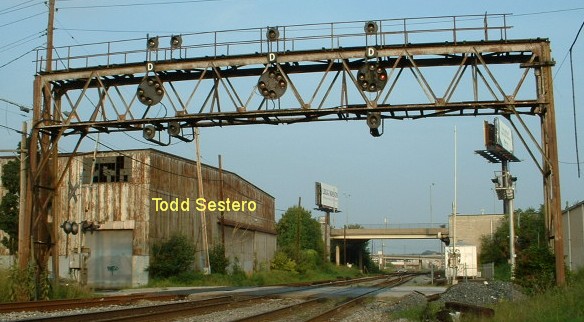 ex B&O, Ridgeley St, Baltimore MD
ex B&O, Ridgeley St, Baltimore MD
You can put a cantilever type signal bridge over them (almost always limited to two tracks)...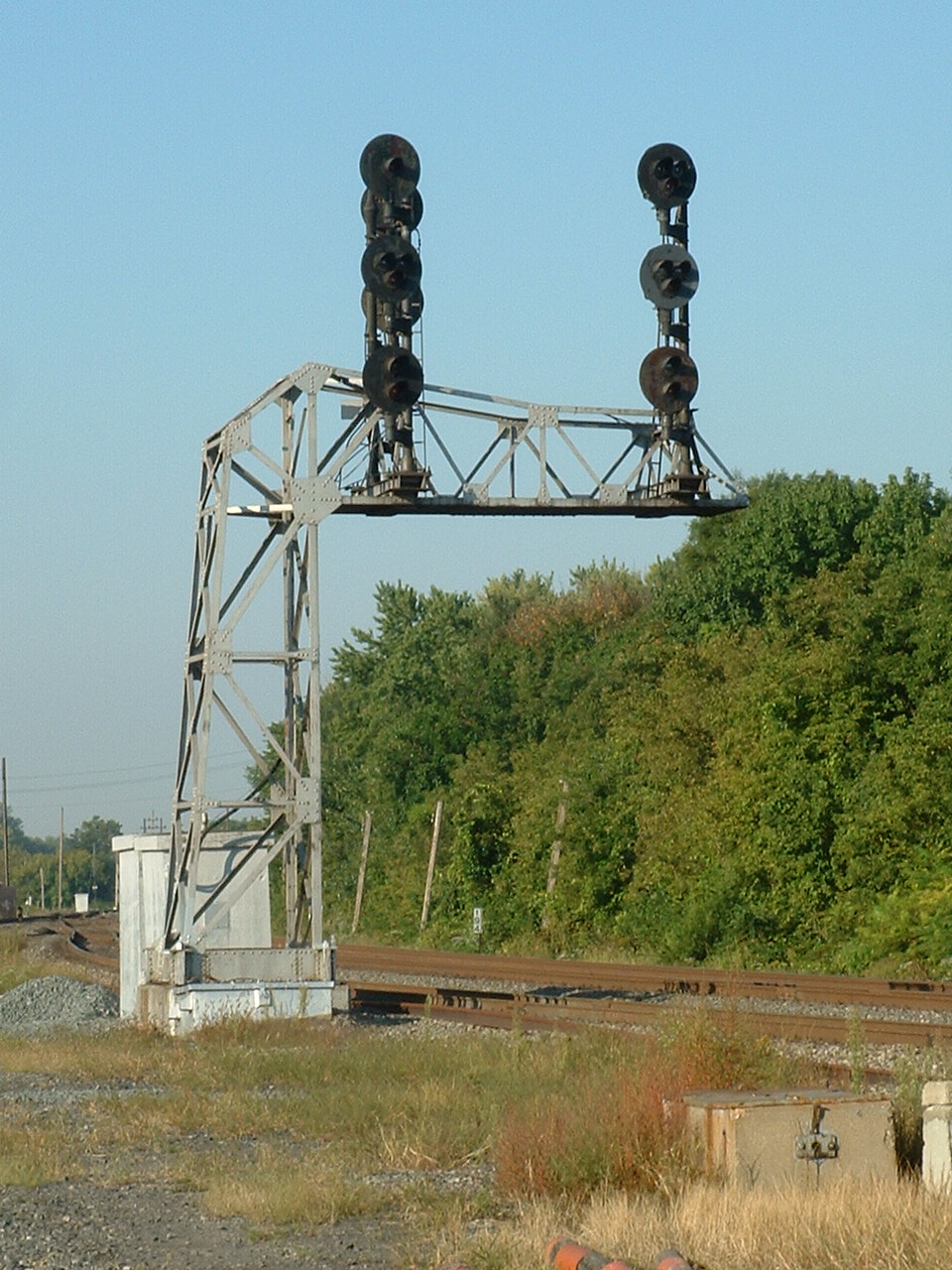
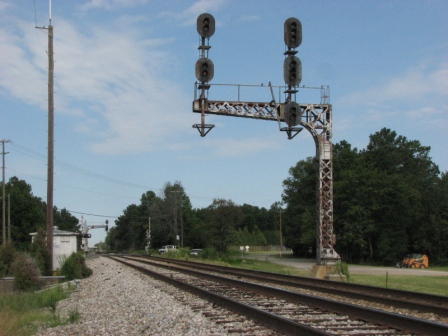
(L) ex NYC, Berea OH, and (R) ex C&O, Richmond VA behind the airport. The one in Berea has disappeared, replaced by color lights sometime in 2010.
(L) ex NYC, Berea OH, and (R) ex C&O, Richmond VA behind the airport. The one in Berea has disappeared, replaced by color lights sometime in 2010.
You can put them on a bracket post..... again, almost always limited to two tracks. See the Doll Posts section for an unusual exception.
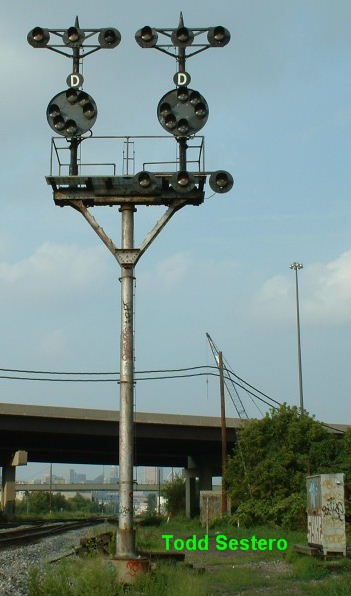
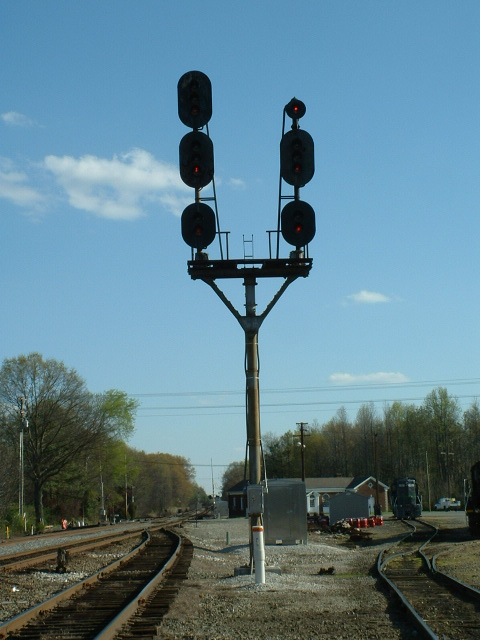

(L) ex B&O, South Baltimore MD... (M) ex RF&P, Doswel VA... (R) Color Signal in Ohio (by Jim Mihalek)
Notice the RF&P signal has a siding between it and the tracks it governs. BTW, the B&O CPL's are now gone, replaced in late 2012 by color lights.


(L) ex B&O, South Baltimore MD... (M) ex RF&P, Doswel VA... (R) Color Signal in Ohio (by Jim Mihalek)
Notice the RF&P signal has a siding between it and the tracks it governs. BTW, the B&O CPL's are now gone, replaced in late 2012 by color lights.
Or, in a non-bridge application, you can put signals on both tracks:
Doll Posts
Now, what happens if you only need the left track (of two) signaled, but the only place you can put the signal is to the right of them? Enter the place holder, or Doll Post(some railroads refer to it as a Doll Arm). The picture below shows how the B&O did it with their CPL signals, this one is north on Baltimore at the end of a siding (hence the dwarf mounted to the bottom of the pole). The post, or arm to the right of the signal tells the engineer that there is a track to the right of the one that the signal is intended for.
The second set of pictures of a US&S Searchlight signal with a doll post in Lineville AL on an ex-SCL line, As with many other railroads, they use a high signal for the mainline and a dwarf for the siding. Notice the blue doll post light is out. Photos courtesy John Higginson.
The last picture is of an ex N&W bracket installation where they have three tracks, and the right one is not signaled with a high signal. They mounted the doll post to an I-beam extension of the bracket. Photo by Jim Mahelik.
Below the pictures is an excerpt from a CSX rulebook that shows the possible combinations a doll post can appear, along with track assignments for bracketed signals.
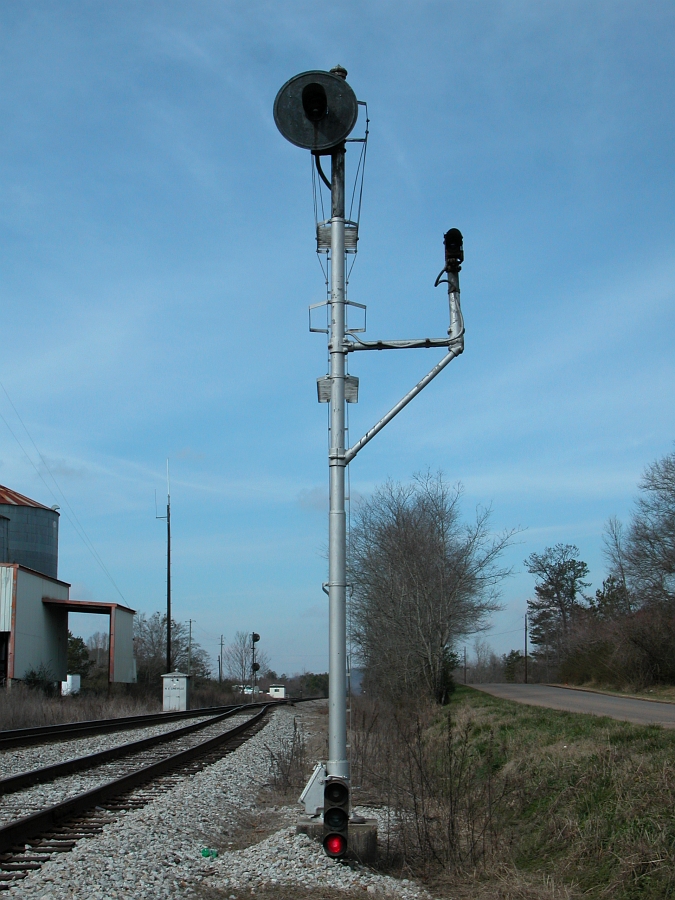
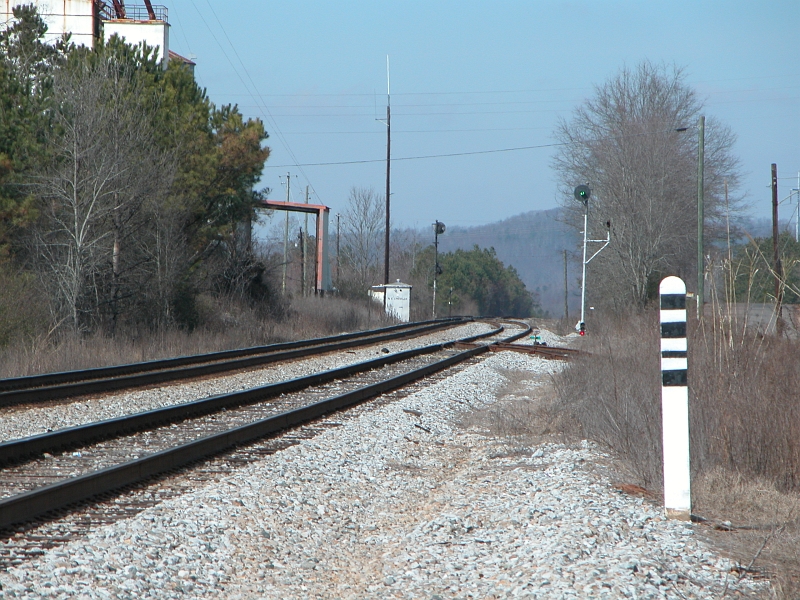
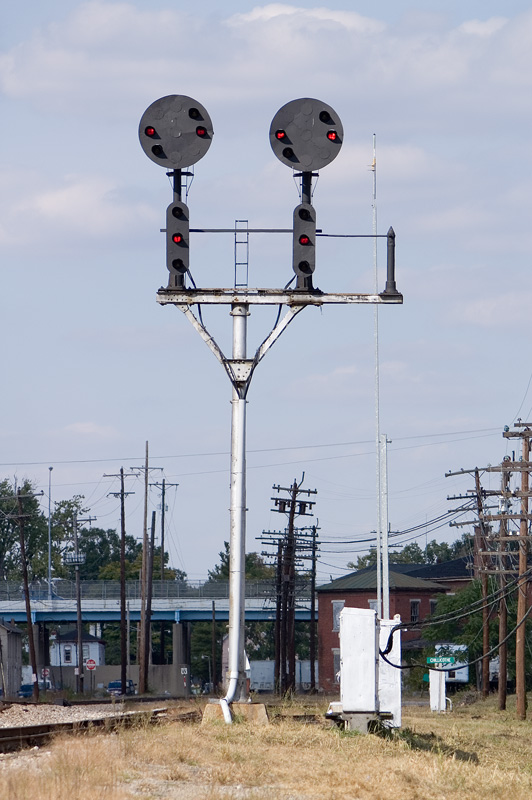
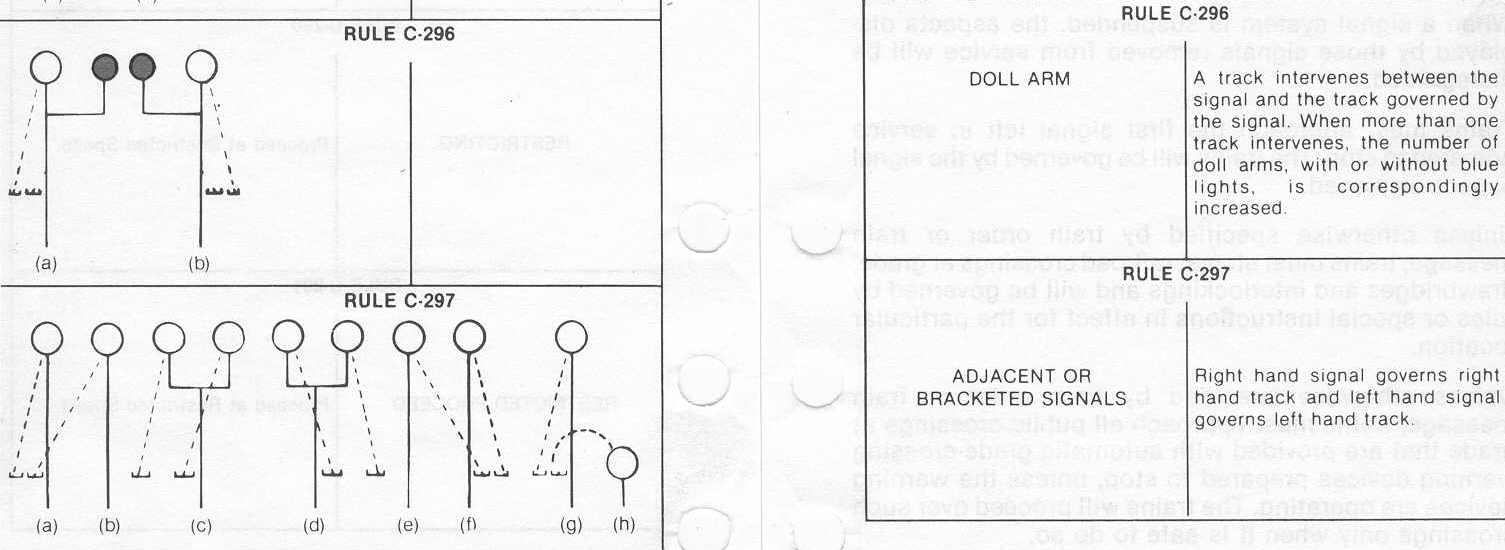
Backgrounds
The background of a signal is the metal shade that surrounds the entire signal or signal head. I have not seen the derivation for this term, but in looking at the old Tombstone signals on the Pennsylvania Railroad, I can clearly see that the background was a separate "device", and not part of the signal.
The main reason for using a background was to make the signal "stick out" when compared to the surrounding environment, especially if the sight line was anywhere near where the sun could be behind the signal. There are some places where backgrounds were not used, such as the lower head of some Pennsy PL signals. Some railroads also used wider than normal backgrounds, such as the Western Maryland, as shown below in Cumberland MD.
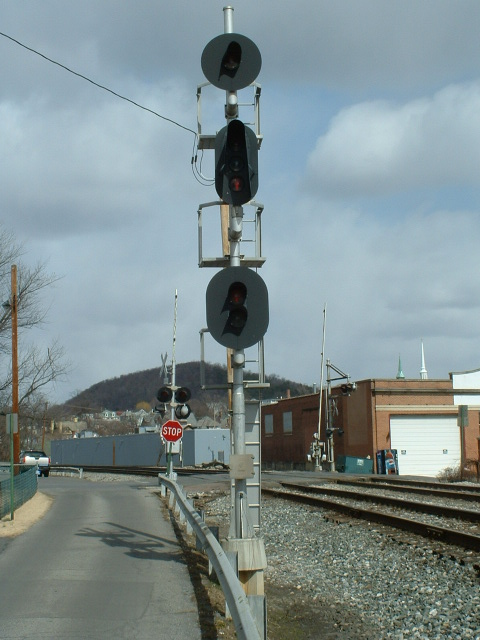
Call-on Signals
A call-on signal (oftentimes red over yellow, or red over red over yellow) displays the *Restricting* indication, which is used for train moves into unsignaled track, against the current of traffic, or into occupied blocks. The latter scenario is the one that gives the "call-on" name. It is "calling a train on[ward]" into an occupied block.
MKT in Texas used a double headed searchlight on their lines... The top head is the larger while the bottom head is smaller. Top head had the H-5mechanism while the bottom heads were ALL fixed yellow aspect. Every single lower head was a fixed yellow. I have heard these were "call-on" signals.
MKT in Texas used a double headed searchlight on their lines... The top head is the larger while the bottom head is smaller. Top head had the H-5mechanism while the bottom heads were ALL fixed yellow aspect. Every single lower head was a fixed yellow. I have heard these were "call-on" signals.
Thu, Apr 11, 2013
Subscribe to:
Posts (Atom)

